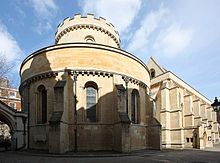Temple Church
| Temple Church | |
|---|---|

Temple Church, view from south-west, showing the original Round Church, now forming the nave
|
|
| Location | Temple City of London EC4Y 7BB |
| Country | England |
| Denomination | Church of England |
| Website | templechurch |
| History | |
| Consecrated | 10 February 1185 |
| Architecture | |
| Functional status | Active |
| Administration | |
| Deanery | City |
| Diocese | London |
| Clergy | |
| Priest(s) |
Robin Griffith-Jones (Master of the Temple) Mark Hatcher (Reader of the Temple) |
| Laity | |
| Director of music | Liz Clarke |
|
Listed Building – Grade I
|
|
| Official name: Temple Church (St Mary's) | |
| Designated | 4 January 1950 |
| Reference no. | 1064646 |
The Temple Church is a late 12th-century church in the City of London located between Fleet Street and the River Thames, built by the Knights Templar as their English headquarters. During the reign of King John (1199–1216) it served as the royal treasury, supported by the role of the Knights Templars as proto-international bankers. It is jointly owned by the Inner Temple and Middle TempleInns of Court, bases of the English legal profession. It is famous for being a round church, a common design feature for Knights Templar churches, and for its 13th and 14th century stone effigies. It was heavily damaged by German bombing during World War II and has since been greatly restored and rebuilt. The area around the Temple Church is known as the Temple and nearby formerly in the middle of Fleet Street stood the Temple Bar, an ornamental processional gateway. Nearby is the Temple Underground station.
In the mid 12th century, before the construction of the church, the Knights Templar in London had met at a site in High Holborn in a structure originally established by Hugues de Payens (the site had been historically the location of a Roman temple in Londinium). Because of the rapid growth of the order, by the 1160s the site had become too confined, and the Order purchased the current site for the establishment of a larger monastic complex as their headquarters in England. In addition to the church, the new compound originally contained residences, military training facilities, and recreational grounds for the military brethren and novices, who were not permitted to go into the City without the permission of the Master of the Temple.
...
Wikipedia
